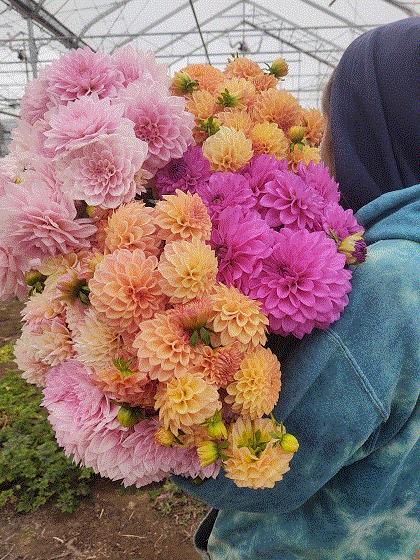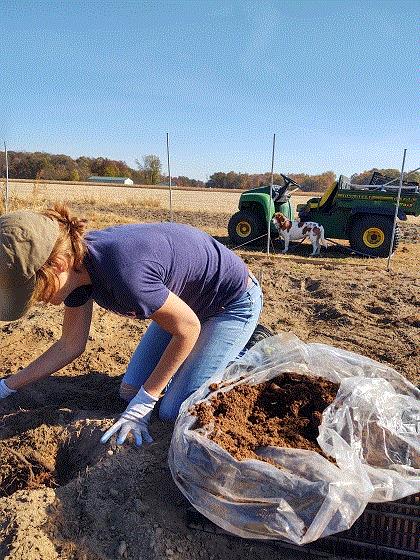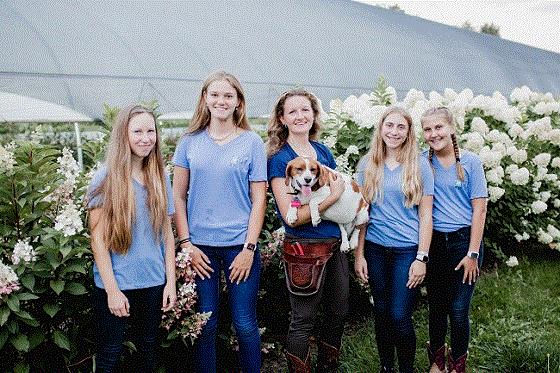End-of-October Farm Update

Pictured are some of our greenhouse dahlias: 'Prospero', 'Lagoon', 'Coralie' and 'Rock Run Ashley'.
Welcome back, everyone! Tater and I hope you all have been enjoying your fall season so far. After our killing frost a few weeks ago the high temperatures have bounced back to over 60F. The high on Monday this week was close to 80F!
The dahlias in the greenhouse are still cranking out stems—they appreciate the unseasonably warm Indian summer. But Tater and I are cutting off orders for dahlias next week since we need to prepare the beds for more spring annuals. It seems dahlias have been scarce on the wholesale market the last few weeks, so the demand for ours has remained steady. Tater and I are making notes for next year to extend the season on the autumnal dahlias.
In addition to cutting fresh dahlia blooms we have been hard at work digging dahlia tubers and planting peonies. In this edition of Bloom Beat we will talk about all aforementioned items plus some personality test things! With all that being said, let’s talk shop.

Peony Planting Primer

A dear friend of mine helped me plant peonies last weekend. Tater supervises in the background.
Last weekend, we planted 450 more peonies. We have approximately 1,750 peonies on the farm now ... needless to say, I have a peony buying addiction!
Whenever we order peonies we are speculating what we can sell three years from now, and this past season was a major success. Some of you folks may be planting peonies as well. If you are not, don’t fret, you can plant in the spring ... although I have been told spring-planted peonies take longer to establish. Fall is the ideal time to plant, but if you are champing at the bit to get peonies established on your farm, I would plant at the earliest opportunity.
For those of you planting peonies this fall, here are a few key points to keep in mind:
When you are selecting a planting spot in your field, make sure it is well-drained. Peonies resent “wet feet”; they should not be in a spot where they will be in standing water.
Peonies are quirky in the sense that you do not want to plant them very deep. The eyes should be 2 to 3 in. below the soil surface. As someone with a landscape/nursery background this seemed counterintuitive to me. But after planting our first few hundred four years ago, I just accepted that that’s how peonies work. They have performed beautifully for us once they matured. If peonies are planted too shallow or too deep they will not flower as prolifically and will struggle.
We plant our peonies in single rows 2 ft. on center, although there are farms that prefer double-row plantings. I personally prefer single rows since the individual plants get better air movement. Foliar diseases such as botrytis and mildews can be a problem, and the increased air movement helps keep these pathogens away.
Also keep in mind that peonies are permanent residents on your farm, and should perform for you the rest of your farming career, so be sure you plant them in a spot where they will succeed. A little forethought and care at planting will pay you dividends for years to come.

Dividing and Storing Dahlias
Digging and dividing dahlia tubers are two of the biggest undertakings on the fall docket. Tater and I wanted to take the time to highlight a few things to keep in mind as you are digging and dividing your dahlias.
For those of you who are new to dahlias, first and foremost be aware that they cannot withstand freezing temperatures. In southeast Michigan we are Zone 6 so we need to dig our dahlias every fall. We are still at the stage of digging our tubers by hand with landscape forks. Flower farmers who grow a substantial amount of dahlias often retrofit a
potato digger to harvest their tubers. As we continue to expand and add more dahlias we will need to come up with a mechanical means of lifting them. Oh, and don't forget to label your dahlias as you dig them!
Once we dig our tubers we rinse off any remaining soil with water. Some growers store their dahlias with the field soil on them in hopes of helping the tubers retain moisture during the winter. We divide our dahlias in the fall, so we rinse the tubers so we can better assess their condition as we divide them.
You can choose to divide your tubers in the fall or in the spring. The pros to dividing in the spring is that the eyes on the tubers become more prominent and it’s much easier to decide where and how to divide them. For us, we are incredibly busy with spring flowers so we have found that dividing in the fall is the only time slot where we can dedicate the man-hours to get it done. One of the best dividing guides I have seen is from Summer Dreams Dahlia Farm, in Oxford Michigan. Here is the
LINK to their webpage. Owner Michael Genovese has done an exceptional job outlining the process he uses to divide dahlias. Dividing dahlias can be intimidating to new growers, but if you read through this a couple times, you will have a better idea of what to do.
After we divide our dahlias we package the tubers in bulb crates, layering the bulbs with wood shavings. We can fit 50 to 60 dahlias per crate.
For storage, we have a repurposed produce cooler from a grocery store. We minimally heat it to 40F using an electric heater controlled by a thermostat. We walk into the dahlia storage area at least once a day during the winter to make sure the heater is working correctly. There are a lot of dahlias in there and we want to make sure that we don’t lose them to freezing!
Once a month, we check the dahlias for rotting and desiccation. Some folks make the mistake of neglecting their dahlias while they are in storage and end up having to scramble the following spring to find tubers to purchase!
Bear in mind that there are plenty of ways to store dahlias. For instance, some growers wrap each tuber in saran wrap and store them in plastic bins. Basically, you need to tailor your dahlia storage method to the quantity of plants you have and what resources you have at your disposal. Just keep in mind that you want adequate humidity to keep them alive while also keeping them dry enough so they don't rot. Dahlias are a Goldilocks crop in the greenhouse and in storage—they like it just right. It may take some trial and error but I promise you it will pay dividends if you can store you dahlias from year to year.
Dahlias are a crop I consider myself married to! They are a ton of work to plant and to harvest and to keep tabs on during the winter months. But when I look at our summer season, the dahlias are the superstars. They are well worth the work, especially as we continue to grow more of them each season.

Personality Tests, Anyone?
 A handful of the Forget Me Not farm crew.
A handful of the Forget Me Not farm crew.
Once we get the dahlias stored for the season, the pace on the farm slows just a touch. I use the late fall/early winter months to do some personal development and to get better-connected with the employees we have on the farm.
One of the ways to get to know an employee is through a personality test. I took the Myers-Briggs test in college and it has been one of the best personality tests I have taken. Myers-Briggs is a self-report questionnaire where participants are defined as having one of sixteen personality types. The personality types are comprised of different traits of each of the following categories: extravert/introvert, sensing/intuition, thinking/feeling, judging/perceiving.
You can visit the Myers-Briggs Foundation
WEBSITE for a more in-depth breakdown of each of the personality types. Bear in mind, no one personality is "better" than the others; each has its own strengths and weaknesses. The questionnaire is considered the gold standard for personality tests.
Regardless of whether or not you decide to use Myers-Briggs for your personality test, I highly encourage you to do something for your employees to better understand them. Not only do you get insight on how your employee communicates but they also get to learn about themselves.
I have said this many times: your people are your best asset. Take the time to get to know them, and invest in them. Every person brings a unique set of skills and talents to an organization. You will be a more effective leader if you can tailor an employee’s work flow to match their strengths. And it will also prevent a ton of headache for both parties. Don’t try to force a square peg into a round hole. An introvert is highly unlikely to enjoy making sales calls. Put your aces in places where they will succeed!
If you have year-round help I highly encourage you to administer some kind of personality test this fall to better connect with them. Even if you have administered personality tests in the past, it is good practice to administer them once a year, especially if your employees are younger.

In Closing
Tater and I need to get back to dividing dahlias. If any of you decide to take the Myers-Briggs personality test we would love to hear your thoughts and experiences with it! Any other ENFP’s out there?
Stay well and talk to you soon!
Lindsay Daschner (and Tater)
Editor-at-Large—Bloom Beat
Owner—Forget-Me-Not Farms
This email was received by 5,859 of your fellow fresh-cut flower growers!
If you're interested in advertising in Bloom Beat, contact Kim Brown and she will hook you up!